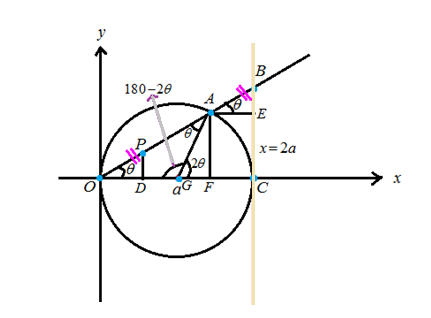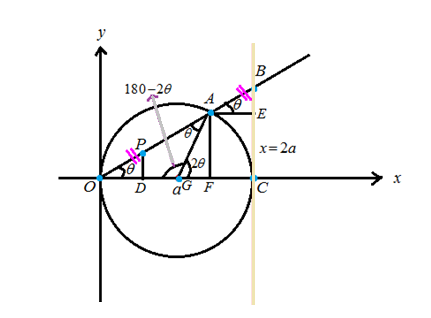
Concept explainers
a.
Find parametric equations for the set of all points
a.
Answer to Problem 34RE
Explanation of Solution
Given information:
Find parametric equations for the set of all points

Calculation:
Consider the figure

Whereas
Hence
For the triangles
Hence
Consider the triangle
Hence
The
Hence the point
To find the point
In the triangle
We know that
Now consider the triangle
And
The
The
Hence, the point
Find the distance
To get the distance
To get the distance
The triangles
Hence, in these two triangles
Hence, the required coordinates of the point
b.
Use the geometric description of the curve to draw a rough of the curve by hand.
b.
Answer to Problem 34RE

Explanation of Solution
Given information:
Use the geometric description of the curve to draw a rough of the curve by hand. Check your work by using the parametric equations to graph the curve.

Calculation:
Draw the curve represented by the parametric equations
This curve is known as cissoids of Diocles.
The graph of the curve is shown below:

Hence, the result is plotted.
Chapter 1 Solutions
Single Variable Calculus: Concepts and Contexts, Enhanced Edition
 Calculus: Early TranscendentalsCalculusISBN:9781285741550Author:James StewartPublisher:Cengage Learning
Calculus: Early TranscendentalsCalculusISBN:9781285741550Author:James StewartPublisher:Cengage Learning Thomas' Calculus (14th Edition)CalculusISBN:9780134438986Author:Joel R. Hass, Christopher E. Heil, Maurice D. WeirPublisher:PEARSON
Thomas' Calculus (14th Edition)CalculusISBN:9780134438986Author:Joel R. Hass, Christopher E. Heil, Maurice D. WeirPublisher:PEARSON Calculus: Early Transcendentals (3rd Edition)CalculusISBN:9780134763644Author:William L. Briggs, Lyle Cochran, Bernard Gillett, Eric SchulzPublisher:PEARSON
Calculus: Early Transcendentals (3rd Edition)CalculusISBN:9780134763644Author:William L. Briggs, Lyle Cochran, Bernard Gillett, Eric SchulzPublisher:PEARSON Calculus: Early TranscendentalsCalculusISBN:9781319050740Author:Jon Rogawski, Colin Adams, Robert FranzosaPublisher:W. H. Freeman
Calculus: Early TranscendentalsCalculusISBN:9781319050740Author:Jon Rogawski, Colin Adams, Robert FranzosaPublisher:W. H. Freeman
 Calculus: Early Transcendental FunctionsCalculusISBN:9781337552516Author:Ron Larson, Bruce H. EdwardsPublisher:Cengage Learning
Calculus: Early Transcendental FunctionsCalculusISBN:9781337552516Author:Ron Larson, Bruce H. EdwardsPublisher:Cengage Learning





